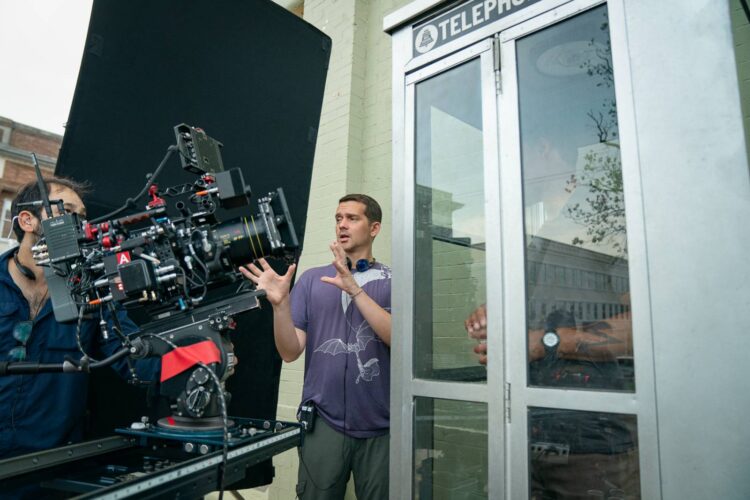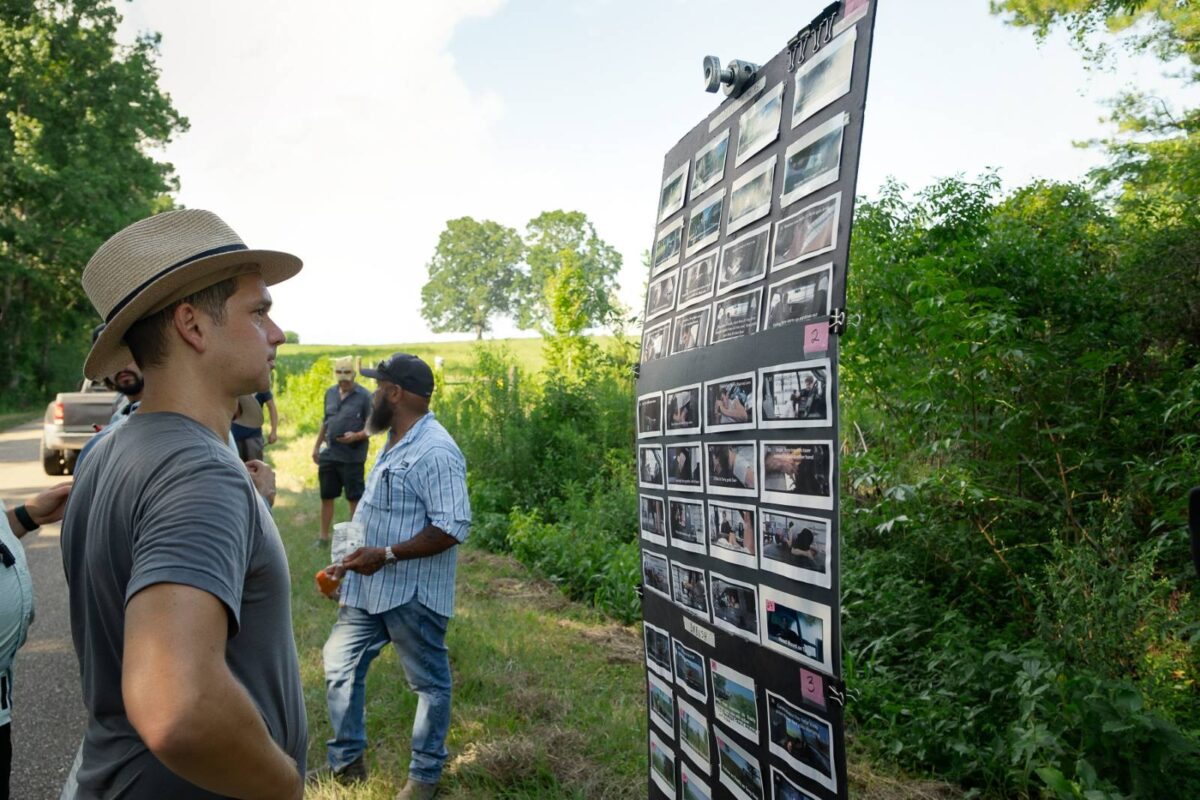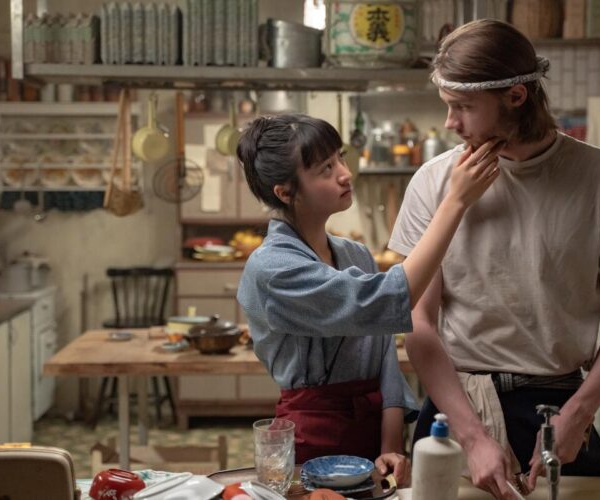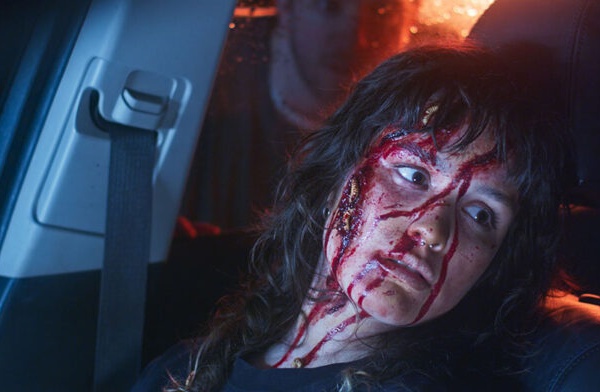

The road for Jeremy Saulnier to realize his fifth feature was one of stops and starts, culminating in a process of nearly five years from the original casting announcement to the film’s arrival on Netflix. However, watching the immensely entertaining Rebel Ridge, one can see no cracks in the surface. Led by a commanding Aaron Pierre as his character battles a bigoted police force in small-town Louisana, it’s a grounded, man-against-the-system thriller that shows Saulnier in top form.
Ahead of the film’s Netflix release, I spoke with Saulnier about his approach to editing, information deprivation, working with cinematographer David Gallego, how he dealt with the production delays, casting Aaron Pierre, carving his own path, and more.
The Film Stage: In all of your movies, but especially here, I appreciate your lack of exposition and even how you approach the editing, where you’re entering a scene and don’t really know the full details of what’s happening until you’re deeper in the scene. Can you talk about that process? Just ensuring that the audience is maybe one step behind in an exciting way.
Jeremy Saulnier: Yeah. For me, this film is a lot of exposition, but it’s earned. Meaning: I put a guy who’s a fish out of water, comes to town, he’s getting sort of battered back and forth between this sort of stifling bureaucracy and jumping through hoops. So he’s seeking knowledge and asking those around him, but I always have that rule, which is: as long as the characters are talking to each other and not the audience, it feels natural. And I definitely adhere to that practice of information deprivation is as powerful as anything you give the audience. So as long as they’re leaning in, it’s working.
Now, if there’s some experts talking over here about something that you don’t know about, as long as it feels like they’re experts. And having the satellite of it’s all from Terry’s point of view, so Terry is completely overwhelmed with this stuff. So if we’re with him, the theory is: if we don’t understand anything, it’s okay, if we can see that Terry also doesn’t quite understand everything, because he’s figured it out, he’s flailing about. But if we understand the emotional truth of our protagonist, then we’re safe. And I do make sure that… it just pings me the wrong way when you’re watching a film and you can tell they’re talking to the audience to make sure they understand. When these cops are talking their lingo or the court clerks are going back and forth in Rebel Ridge, it’s between them, so you got to catch up.
This is your first time working with cinematographer David Gallego. I really love a lot of his past work, with Embrace of the Serpent and I Am Not a Witch. I’m just curious the first things you saw from him and how your process was collaborating. The cinematography is really great and there’s such a focused propulsion to the camera movement.
David I sought out. A collaboration of mine, Magnus Jønck, was here in the initial version of the film, but he couldn’t come back a third year. As a former cinematographer, I just needed that and I found that in David Gallego. He is an amazing artist. I mean, his work is Oscar-nominated as far as Best International Feature. I’m sitting here doing my biggest film––multi-camera, studio picture, a big footprint. You move a little slower, but it’s tough. How do I keep myself true to my nature as a filmmaker? I need to hire not just the most rad dude that can put the hat on backwards and make the day and order equipment, but a true artist, as highfalutin as that sounds.
He was my insurance policy, you know? So when I did get off-track, at the helm of the visual storytelling was David Gallego. We flew him in from Colombia. His artistry led the way and his lighting is soft and supple and realistic. And he can work with hard light bouncing and this and that. But it’s always naturalistic and always authentic, and that’s where I need to make sure. Because when you have three cameras rolling, the intention was always to make it feel like it was a single-camera, cinematic feeling, with artists at the helm. And sometimes you have to work extra-hard, as your footprint expands, to make that a reality. But he’s also a lovely guy. And that’s important in the casting process whether it be, you know, on-screen talent or technicians. And he’s a true artist and a gentleman. He’s amazing and we will be working together again.
Oh, that’s very exciting. You mentioned you’ve worked on this for a number of years with different stops and starts. Did you make the most of that time in the sense of having more time to refine the script or did you not touch it?
We had headwinds, we had starts and stops, and I did the opposite: I did not allow myself to open the hood and look at it. I knew I had that sort of naive, wonderful energy when you first have a film before you, and you want to go realize the script onto the screen. As I got protracted, to keep my energy and my true love of the project live, I went and did other things. So I do a commercial, or I start a new script, and purposely not even look at the Rebel Ridge script because I didn’t want tinker with it. I didn’t want to sort of muddy or dilute what I had. What I did have was exciting to me and had energy.
I did a couple of things; the studio and I went back and forth a few times to make sure things got more clear. Sometimes, as events unfolded, I was able to remove exposition. People sort of got things more. I didn’t need to teach a full history lesson on civil asset forfeiture; I can just take a few lines out. Other than than, almost no changes to the script to preserve that initial energy. And I’m glad I kept it pristine. I didn’t even look at the script for a full calendar year.
Oh, wow.
I dug into scenes and sequences like I was ready and prepared on-set, but as far as the big picture, I actually would not allow myself to second-guess it. Even 18 months into the post process, we were wrapping it up. I finally watched the film from start to finish because, again, I wrote it, I engineered it, I shot it––I knew it too well. So I wanted to be surprised. Lo and behold, I sat there with an audience. Usually I get that gut punch and I get the dreadful feeling of “my career is over.” You know, all the things. But I spent so much time away from it that when I finally saw it, I was elated. And I just took some notes and wrapped it up. And within a month we locked picture and I preserved my love all the way through. This is the first time releasing a movie of mine where I’m fully at peace and in love upon release, which is exciting.
That’s great. Your lead, Aaron Pierre, has such an incredible presence in the movie. He can be so still throughout that when his eyes dart one way it can feel like he punches someone because of his intensity. Can you talk about your discussions with him about the character?
It’s hard to even remember discussing the character. My wife had seen him in The Underground Railroad and I was in New Orleans. I turned on an episode of that and I said, “Oh, this guy has real chops. Let me talk to him.” And then we got on a video call and within two minutes,, I knew that he was the only version of Terry Richmond I could ever really see from that moment forward. So it was great. He was quiet, composed, thoughtful. He had that sort of cerebral weight to him that I needed for this character. Because Terry Richmond is not just like an action badass. He is a guy who has etiquette. He has this very even-keeled center. He’s cordial and he’s trying to sort of find his way.
He’s certainly put through the wringer in this film, but when Aaron came aboard it was kind of effortless. We talked about character beats, story beats, the vernacular of the film, Americanisms, and the dialogue, but nothing too deep. Aaron really self-generated a lot of that because he just read the scripts and collaborators can tell when they properly interpret each other. There’s so much synchronicity that there doesn’t need to be much. Now, the physicality of the role, we put him through that with the stunt team, and that was, like, so technical as far as the camera movement. He’s sitting there dodging smoke grenades or whatever, but he was really patient with me because I guess, unfortunately for him, it had to be actually Aaron Pierre doing most of the stunt work in the fighting because I’m right there with you and it can’t be some other guy.
It’s a great performance. You mentioned you were trying to throw back a bit to ’80s and ’90s thrillers, the more grounded sense of them. When the trailer came out there was obvious comparison to First Blood. Did you go back and actually watch those films for inspiration, or are you trying to keep your head clear?
Yeah, definitely try to carve my own path. I’m absolutely influenced by those films, but I need to allow room to define my own narrative. But as soon as I did pit one guy against a small town, of course, it’s my take on First Blood. It’s far different, but when you distill this thing down to a trailer, of course, it’s cool. And I welcome that. I actually was aware of that in the writing process, and I kept myself from adding a Colonel Trautman joke to one of the scenes. It’s a temptation, but I was like, “This has to be its own universe. I don’t want to hint at other movies.” But the films that I’m referencing become apparent after I’ve actually seen the finished movie. You’re like, “Oh, I pulled that from Beverly Hills Cop. Oh, that’s like Enemy of the State. Oh, that’s like the scene I watched in Thunderheart. And that is one for my Michael Clayton moment.” So I get that too. But I definitely don’t want to overtly reference anything, just out of respect for the story we’re telling and for the actors. I don’t want to tell Aaron like, “Hey, remember that moment in some other movie? We’re doing that!” I need this to be very true and singular to him as an actor and as a character.

I love one of the behind-the-scenes stills that was released of you looking at the storyboards on set. I’m just curious: what does a normal day look like? Is it making sure each shot is exactly how you planned out? Or how much room for flexibility do you allow?
I mean, it was tough down there in Louisiana. It was hot as hell. I think Aaron was wrapping Foe for Amazon. So we had to push the schedule a little bit. So we were kind of getting into the real heat. We had a heat index of 128°F. It was dangerous at times. So we were very careful to make sure we didn’t put anyone in jeopardy. But we’re out there. Aaron’s determined to get it right and so am I. So just the physicality was tough. It was hot as hell. If the camera and Terry weren’t aligned just perfectly and the shotgun didn’t land where it should. Or the smoke didn’t come through frame to sort of give him a curtain to reveal himself, all these things, you’re kind of at the mercy of a hundred elements at once.
Sometimes we had a day where it would be dialogue or maybe a soundstage. And it was fun to have that contrast. You’re at the mercy of the elements. It’s so technical. It’s all about timing and physicality and cueing things and blowing that up or firing that. And then you have these moments where you’re just sitting in a set that’s built and the Louisiana weather can’t get you. You’re there and you let actors just talk. So it was a lot of long, hard days, sometimes just sitting there golden and raking in sunlight. It’s absolutely beautiful. But you are shut down because, in Louisiana, there’s a thunderstorm five miles from you and because of the safety of everyone involved, you’re just sitting there. That’s frustrating as a filmmaker, but of course, not really an issue as a human. You’ve got to keep it safe. We had a wide variety. We sort of did the whole spectrum of quiet interiors and just talking, like Summer and Terry in the kitchen, then absolute mayhem out in front of that police station.
Rebel Ridge arrives on Netflix on Friday, September 6.
The post Jeremy Saulnier on Rebel Ridge, the Power of Information Deprivation, and Staying Energized Through Production Delays first appeared on The Film Stage.



